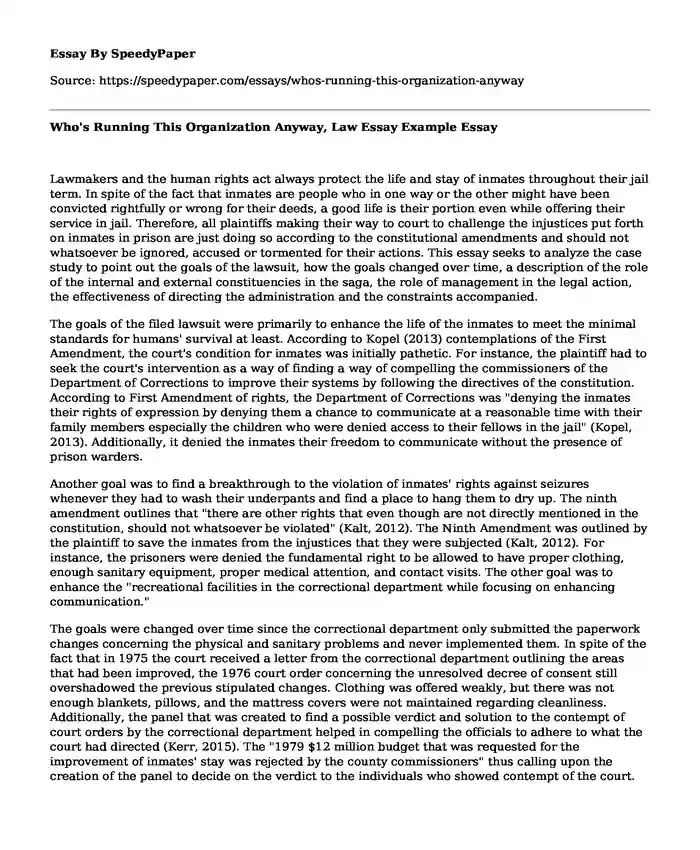
| Type of paper: | Essay |
| Categories: | Court system |
| Pages: | 3 |
| Wordcount: | 684 words |
Lawmakers and the human rights act always protect the life and stay of inmates throughout their jail term. In spite of the fact that inmates are people who in one way or the other might have been convicted rightfully or wrong for their deeds, a good life is their portion even while offering their service in jail. Therefore, all plaintiffs making their way to court to challenge the injustices put forth on inmates in prison are just doing so according to the constitutional amendments and should not whatsoever be ignored, accused or tormented for their actions. This essay seeks to analyze the case study to point out the goals of the lawsuit, how the goals changed over time, a description of the role of the internal and external constituencies in the saga, the role of management in the legal action, the effectiveness of directing the administration and the constraints accompanied.
The goals of the filed lawsuit were primarily to enhance the life of the inmates to meet the minimal standards for humans' survival at least. According to Kopel (2013) contemplations of the First Amendment, the court's condition for inmates was initially pathetic. For instance, the plaintiff had to seek the court's intervention as a way of finding a way of compelling the commissioners of the Department of Corrections to improve their systems by following the directives of the constitution. According to First Amendment of rights, the Department of Corrections was "denying the inmates their rights of expression by denying them a chance to communicate at a reasonable time with their family members especially the children who were denied access to their fellows in the jail" (Kopel, 2013). Additionally, it denied the inmates their freedom to communicate without the presence of prison warders.
Another goal was to find a breakthrough to the violation of inmates' rights against seizures whenever they had to wash their underpants and find a place to hang them to dry up. The ninth amendment outlines that "there are other rights that even though are not directly mentioned in the constitution, should not whatsoever be violated" (Kalt, 2012). The Ninth Amendment was outlined by the plaintiff to save the inmates from the injustices that they were subjected (Kalt, 2012). For instance, the prisoners were denied the fundamental right to be allowed to have proper clothing, enough sanitary equipment, proper medical attention, and contact visits. The other goal was to enhance the "recreational facilities in the correctional department while focusing on enhancing communication."
The goals were changed over time since the correctional department only submitted the paperwork changes concerning the physical and sanitary problems and never implemented them. In spite of the fact that in 1975 the court received a letter from the correctional department outlining the areas that had been improved, the 1976 court order concerning the unresolved decree of consent still overshadowed the previous stipulated changes. Clothing was offered weakly, but there was not enough blankets, pillows, and the mattress covers were not maintained regarding cleanliness. Additionally, the panel that was created to find a possible verdict and solution to the contempt of court orders by the correctional department helped in compelling the officials to adhere to what the court had directed (Kerr, 2015). The "1979 $12 million budget that was requested for the improvement of inmates' stay was rejected by the county commissioners" thus calling upon the creation of the panel to decide on the verdict to the individuals who showed contempt of the court.
The internal constituencies in the saga were the one responsible for delaying the implementation of the court's orders. The external constituencies involved the plaintiff who made it a success for the system to improve the jail life. According to Kalt (2012), the management's role was to align with the ninth amendment in checking the efficacy of the plaintiff's claims in conjunction with the court's ruling to find a possible way of finding the desired solution.
References
Kerr, O. S. (2015). The Fourth Amendment and the Global Internet. Stan. L. Rev., 67, 285.
Kopel, D. B. (2013). The First Amendment Guide to the Second Amendment. Tenn. L. Rev., 81, 417.
Kalt, B. C. (2012). The Ninth Amendment in Congress. Pepp. L. Rev., 40, 75.
Cite this page
Who's Running This Organization Anyway, Law Essay Example. (2022, Apr 28). Retrieved from https://speedypaper.com/essays/whos-running-this-organization-anyway
Request Removal
If you are the original author of this essay and no longer wish to have it published on the SpeedyPaper website, please click below to request its removal:
- Free Essay on the Rise in Eating Disorders in Middle-Aged Women
- Free Essay on Education
- Employee Benefit Plans - Essay Example in Performance Management
- Essay Sample with the Published Experimental Design Checklist Comparison
- Nursing Essay Example: Peer Interview
- Essay Sample on The Effects of False Negatives and False Positives
- Free Essay. Public Awareness on Climate Change
Popular categories




